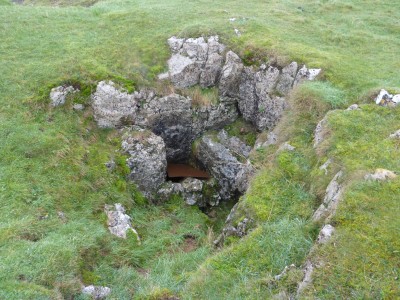17th January 2016: a damp, misty morning stroll with my wife Roz and my dog Buster. Walked up Middle Down Drove to the gate leading into Middle Down Reserve.
 There is a line of boundary stones(?) alongside the track into Middle Down Reserve. We walked across the reserve towards Cheddar Head to pick up the track to Totty Pot.
There is a line of boundary stones(?) alongside the track into Middle Down Reserve. We walked across the reserve towards Cheddar Head to pick up the track to Totty Pot.

Totty Pot got its name when the only digging implement Chris Hawkes, the finder of this cave in the 1960’s, could lay his hands on was his daughters potty. His daughter couldn’t pronounce the word ‘potty’ and would say ‘totty’ instead.
The cave is located about 5km east of Cheddar, on the plateau that forms the top of Mendip, at approx. 245m OD, where the covered entrance shaft is about 4m deep and 0.75m width with short passages leading east and west at the bottom.
WCC dug into
the cave in 1961 for speleological reasons this resulted in the loss of a
number of artefacts during the early exploration. WCC went on to carry out an
archaeological dig in Mesolithic and later deposits in 1964. Further excavation by the University of Bristol Spelaeological
Society around the entrance area in 1998 suggests that there was no human
occupation evidence and the flint debitage is likely to have been the result of
re-sharpening hunting tools, and the finished tools being hunting losses. The assemblage of human and animal bone, includes both
wild and domestic species, as well as a small microlithic flint assemblage, a
barbed and tanged arrowhead, along with sherds of Beaker and Early to Middle
Bronze Age pottery. A radiocarbon date indicates at least one Mesolithic human,
dating to 7450→7050 cal BC, further AMS dating confirms the Mesolithic date for
the same individual, however five other individuals date to the Neolithic
spanning much of the period ranging from 3630-3370 cal BC to 3340-3000 cal BC
(Ref: Simmonds, V.J. An overview of the archaeology of Mendip caves and karst. Online at Mendip cave archaeology – www.mendipgeoarch.net).
 By the track this recently cleared out dew pond.
By the track this recently cleared out dew pond.

 31st January 2016: Walking with Roz and Buster. Stormy weather so we decided to go where there was more shelter to be found and a walk around Rowberrow woods. There are forestry operations being carried out at the moment so a bit mucky underfoot in places. There is something about freshly felled and cut wood on the hillside, reminds me of being in the Alps where the sound of timber being cut echoed across the valleys and the aroma of cut pine was in the air. Not very many people about today which was also good. Some large swathes of trees have cleared opening up areas of the wood, unfortunately this has had the effect of exposing more trees to the strong winds and there are a lot of wind blown trees lying on the ground. I suppose these will eventually be cleared away. The shelter the trees give from the wind is noticeable as you pass from cleared hillside to were the trees are untouched – yet.
31st January 2016: Walking with Roz and Buster. Stormy weather so we decided to go where there was more shelter to be found and a walk around Rowberrow woods. There are forestry operations being carried out at the moment so a bit mucky underfoot in places. There is something about freshly felled and cut wood on the hillside, reminds me of being in the Alps where the sound of timber being cut echoed across the valleys and the aroma of cut pine was in the air. Not very many people about today which was also good. Some large swathes of trees have cleared opening up areas of the wood, unfortunately this has had the effect of exposing more trees to the strong winds and there are a lot of wind blown trees lying on the ground. I suppose these will eventually be cleared away. The shelter the trees give from the wind is noticeable as you pass from cleared hillside to were the trees are untouched – yet.
 There is a line of boundary stones(?) alongside the track into Middle Down Reserve. We walked across the reserve towards Cheddar Head to pick up the track to Totty Pot.
There is a line of boundary stones(?) alongside the track into Middle Down Reserve. We walked across the reserve towards Cheddar Head to pick up the track to Totty Pot.
 By the track this recently cleared out dew pond.
By the track this recently cleared out dew pond.
